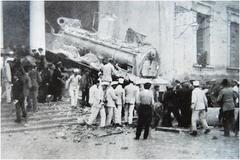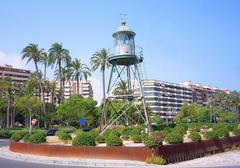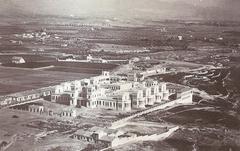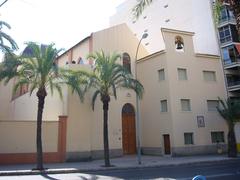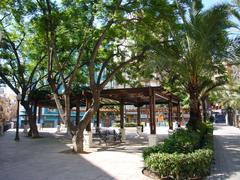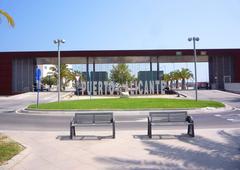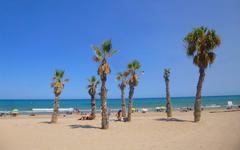
Plaza de Toros de Alicante: Complete Visitor Guide to Hours, Tickets, History, and Cultural Significance
Date: 04/07/2025
Introduction
Located in the vibrant heart of Alicante, the Plaza de Toros de Alicante is one of Spain’s most distinguished bullrings and a celebrated symbol of the city’s enduring cultural heritage. Since its original construction in 1847 and major reconstruction in 1888, this neoclassical monument has evolved from a traditional arena for bullfighting into a dynamic venue offering guided tours, immersive museum exhibits, and a packed calendar of concerts, festivals, and local events. Today, it stands as both a testament to Alicante’s rich past and a lively gathering place for locals and visitors alike. This guide provides comprehensive, up-to-date information on visiting hours, ticketing, accessibility, historical background, and travel tips—ensuring an enriching and memorable experience for every guest. For the latest updates and bookings, consult official sources such as Entradas Toros Alicante, Plaza Toros Alicante official website, and trusted tourism portals including alicanteturismo.com and visitcostablancaspain.com.
Table of Contents
- Introduction
- Historical Overview and Bullfighting Tradition
- Architectural Evolution and Features
- Cultural Significance and Community Role
- Festivals, Events, and Multifunctional Uses
- Museo Taurino de Alicante
- Visitor Information: Hours, Tickets, Tours, Accessibility
- Travel Tips and Nearby Attractions
- Frequently Asked Questions (FAQ)
- Visual and Interactive Resources
- Summary and Final Tips
- References
Historical Overview and Bullfighting Tradition
Bullfighting has been a part of Alicante’s identity since at least the 15th century, when makeshift wooden arenas hosted early spectacles. By the 19th century, the growing popularity of tauromachia led to the commissioning of a permanent bullring in 1847 under architect Emilio Jover Perrón, who also designed the city’s Teatro Principal. The original structure quickly became a focal point for local festivities and social life (entradastorosalicante.com).
A major reconstruction in 1888, led by José Guardiola Picó, introduced a more resilient, monumental design and increased capacity. The grand reopening was marked by the performances of legendary matadors and established Alicante as a significant stop on the Spanish bullfighting circuit (alicanteturismo.com). Over the decades, the bullring has seen renovations to enhance safety and accessibility, most notably in 1986, ensuring its continued use as a leading venue in the 21st century.
Architectural Evolution and Features
The Plaza de Toros de Alicante exemplifies 19th-century Spanish neoclassical architecture, with a circular layout and tiered seating designed for optimal viewing. Currently, the arena accommodates around 11,600 spectators. Notable features include:
- Gran Patio de Caballos: Courtyard for horses and riders.
- Chiqueros: Bulls’ holding pens.
- Enfermería: Fully equipped infirmary for emergencies.
- Chapel: Used by matadors for pre-event prayers.
These elements preserve the authentic character of the bullring while supporting its diverse functions today (alicanteturismo.com).
Cultural Significance and Community Role
More than an architectural landmark, the Plaza de Toros is deeply woven into Alicante’s social and cultural fabric. It not only hosts traditional bullfighting events but also serves as a venue for civic celebrations, concerts, and community gatherings. The arena is especially significant during the annual Feria de las Hogueras de San Juan, a major festival that fills Alicante with music, fireworks, and vibrant parades (entradastorosalicante.com). The bullring is also a site of artistic inspiration, having appeared in literary works and artworks exploring themes of honor, ritual, and the passage of time.
Festivals, Events, and Multifunctional Uses
The Plaza de Toros is at the heart of the Hogueras de San Juan festival each June, with tens of thousands attending bullfights and concerts during this period (eventosmarenostrum.com). The venue is also renowned for hosting performances by major artists such as Joaquín Sabina, Tom Jones, and Miguel Bosé, as well as community events, political rallies, and exhibitions (ariaspain.com).
Museo Taurino de Alicante
Located within the bullring complex, the Museo Taurino offers a fascinating journey through Alicante’s bullfighting history. Exhibits include matador costumes, memorabilia, historical documents, and educational displays exploring the cultural and ethical complexities of tauromachia. Admission to the museum is generally included with guided tour tickets (alicanteturismo.com).
Visitor Information: Hours, Tickets, Tours, Accessibility
Visiting Hours
- Guided Tours & Museum: Tuesday–Sunday, 10:00 AM–7:00 PM (closed Mondays and public holidays; hours may vary during festivals)
- Bullfighting Events & Concerts: Doors open approximately two hours before event start time
Tickets
- Guided Tour (with museum): €12 general admission; €8 for children (6–12) and seniors (65+); free for children under 6
- Event Tickets: Vary by event and seating; purchase in advance for major festivals
Buy tickets online via the official box office or authorized vendors such as Entradas Toros Alicante. Advance booking is recommended, especially during the Hogueras de San Juan.
Guided Tours and Immersive Experiences
Tours are available in multiple languages and include highlights such as the Puerta Grande, Patio de Cuadrillas, infirmary, bull pens, upper stands, and the presidential box. A virtual reality segment lets visitors “fly” over the arena, trace a bull’s journey, and simulate a bullfight at a renowned ranch. Guests can also enter the arena, handle a capote (bullfighter’s cape), and pose for photos (informacion.es).
Accessibility
The bullring provides ramps, accessible seating, and assistance upon request. Contact staff ahead of your visit for specific needs.
Travel Tips and Nearby Attractions
- Getting There: The Plaza de Toros is centrally located at Plaza España, 7, 03010 Alicante—easily accessible by foot, bus, or car. Paid parking is available nearby; arrive early during major events (visitcostablancaspain.com).
- Dining: Numerous restaurants and tapas bars in the area offer local specialties such as paella alicantina and fresh seafood (ariaspain.com).
- Nearby Attractions: Combine your visit with the Santa Bárbara Castle, Mercado Central, Explanada de España, and Alicante’s historic old town for a full cultural itinerary.
Frequently Asked Questions (FAQ)
Q: What are the Plaza de Toros de Alicante’s visiting hours?
A: Guided tours and museum are open Tuesday–Sunday, 10:00 AM–7:00 PM; hours may vary during events.
Q: How do I purchase tickets?
A: Buy tickets online via the official box office or authorized vendors. Advance booking is advised.
Q: Are guided tours available?
A: Yes, guided tours (with audio guides in several languages) run daily except Mondays and public holidays.
Q: Is the site accessible for visitors with disabilities?
A: Yes, with ramps, accessible seating, and staff assistance.
Q: Can children visit?
A: Children are welcome for tours and museum visits. Bullfighting events may not be suitable for young children.
Q: Are there virtual tours?
A: Yes, the on-site tour includes a virtual reality segment, and an official virtual tour is available online.
Visual and Interactive Resources
Explore high-quality images, virtual tours, and interactive maps on the Plaza de Toros official website to plan your visit and preview the venue’s architecture and exhibits.
Summary and Final Tips
The Plaza de Toros de Alicante stands as a living monument to the city’s history and cultural vibrancy. From its neoclassical architecture and legendary festival bullfights to immersive museum exhibits and virtual reality experiences, the bullring offers something for everyone—whether you are a history buff, culture enthusiast, or simply curious traveler. To make the most of your visit, check official platforms for current hours and ticketing, book tours in advance during busy periods, and consider exploring nearby attractions for a well-rounded Alicante itinerary. For exclusive content and the latest updates, download the Audiala app and follow local cultural channels.
References
- Plaza de Toros de Alicante: Visiting Hours, Tickets, and Historical Guide to Alicante’s Iconic Bullring, 2025, (entradastorosalicante.com)
- Plaza De Toros De Alicante: Visiting Hours, Tickets & Cultural Significance of Alicante’s Historic Bullring, 2025, (alicante.com)
- Plaza de Toros de Alicante Visiting Hours, Tickets, and Cultural Guide, 2025, (visitcostablancaspain.com)
- Plaza de Toros de Alicante: Visiting Hours, Tickets, History, and Cultural Insights, 2025, (whatalicante.com)
- Informacion.es - Plaza de Toros de Alicante Visitor Report, 2025, (informacion.es)
- Alicante Turismo - Plaza de Toros de Alicante Monument, 2025, (alicanteturismo.com)
- Ariaspain.com - Cultural Guide to Plaza de Toros de Alicante, 2025, (ariaspain.com)
- EventosMareNostrum.com - Bullfighting Events in Alicante 2025, (eventosmarenostrum.com)




